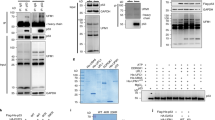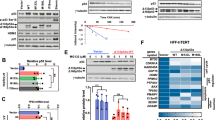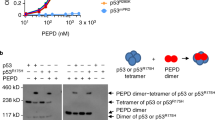Abstract
The E3 ubiquitin ligase Mdm2 is a focal regulator of p53 tumour suppressor activity. It binds p53, promoting its polyubiquitination and degradation, and also controls p53 synthesis. However, it is not known how this dual function of Mdm2 on p53 synthesis and degradation is achieved. Here we show that the p53 mRNA region encoding the Mdm2-binding site interacts directly with the RING domain of Mdm2. This impairs the E3 ligase activity of Mdm2 and promotes p53 mRNA translation. We also show that introduction of cancer-derived single silent point-mutations in the p53 mRNA weakens its binding to Mdm2 and results in reduced p53 activity. These data are consistent with a mechanism by which changes in silent nucleotides can affect the function of the encoded protein, and indicate that Mdm2-mediated control of p53 synthesis and degradation has evolved in the p53 mRNA sequence and its encoded amino acids.
This is a preview of subscription content, access via your institution
Access options
Subscribe to this journal
Receive 12 print issues and online access
$209.00 per year
only $17.42 per issue
Buy this article
- Purchase on SpringerLink
- Instant access to full article PDF
Prices may be subject to local taxes which are calculated during checkout




Similar content being viewed by others
References
Zhu, J., Zhou, W., Jiang, J. & Chen, X. Identification of a novel p53functional domain that is necessary for mediating apoptosis. J. Biol. Chem. 273, 13030–13036 (1998).
Kubbutat, M. H., Jones, S. N. & Vousden, K. H. Regulation of p53 stability by Mdm2. Nature 387, 299–303 (1997).
Haupt, Y., Maya, R., Kazaz, A. & Oren, M. Mdm2 promotes the rapid degradation of p53. Nature 387, 296–299 (1997).
Yin, Y., Stephen, C. W., Luciani, M. G. & Fahraeus, R. p53 Stability and activity is regulated by Mdm2-mediated induction of alternative p53 translation products. Nature Cell Biol. 4, 462–467 (2002).
Kussie, P. H. et al. Structure of the MDM2 oncoprotein bound to the p53 tumor suppressor transactivation domain. Science 274, 948–953 (1996).
Candeias, M. M. et al. Expression of p53 and p53/47 are controlled by alternative mechanisms of messenger RNA translation initiation. Oncogene 25, 6936–6947 (2006).
Ray, P. S., Grover, R. & Das, S. Two internal ribosome entry sites mediate the translation of p53 isoforms. EMBO Rep. 7, 404–410 (2006).
Honda, R., Tanaka, H. & Yasuda, H. Oncoprotein MDM2 is a ubiquitin ligase E3 for tumor suppressor p53. FEBS Lett. 420, 25–27 (1997).
Oscier, D. G. et al. Multivariate analysis of prognostic factors in CLL: clinical stage, IGVH gene mutational status, and loss or mutation of the p53 gene are independent prognostic factors. Blood 100, 1177–1184 (2002).
Perry, M. E. Mdm2 in the response to radiation. Mol. Cancer Res. 2, 9–19 (2004).
Cheng, T. H. & Cohen, S. N. Human MDM2 isoforms translated differentially on constitutive versus p53-regulated transcripts have distinct functions in the p53/MDM2 and TSG101/MDM2 feedback control loops. Mol. Cell Biol. 27, 111–119 (2007).
Marechal, V., Elenbaas, B., Piette, J., Nicolas, J. C. & Levine, A. J. The ribosomal L5 protein is associated with mdm-2 and mdm-2-p53 complexes. Mol. Cell Biol. 14, 7414–7420 (1994).
Elenbaas, B., Dobbelstein, M., Roth, J., Shenk, T. & Levine, A. J. The MDM2 oncoprotein binds specifically to RNA through its RING finger domain. Mol. Med. 2, 439–451 (1996).
Rackham, O. & Brown, C. M. Visualization of RNA-protein interactions in living cells: FMRP and IMP1 interact on mRNAs. EMBO J. 23, 3346–3355 (2004).
Nagai, T. et al. A variant of yellow fluorescent protein with fast and efficient maturation for cell-biological applications. Nature Biotechnol. 20, 87–90 (2002).
Mathews, D. H., Sabina, J., Zuker, M. & Turner, D. H. Expanded sequence dependence of thermodynamic parameters improves prediction of RNA secondary structure. J. Mol. Biol. 288, 911–940 (1999).
Fang, S., Jensen, J. P., Ludwig, R. L., Vousden, K. H. & Weissman, A. M. Mdm2 is a RING finger-dependent ubiquitin protein ligase for itself and p53. J. Biol. Chem. 275, 8945–8951 (2000).
Juven, T., Barak, Y., Zauberman, A., George, D. L. & Oren, M. Wild type p53 can mediate sequence-specific transactivation of an internal promoter within the mdm2 gene. Oncogene 8, 3411–3416 (1993).
Unger, T. et al. Mutations in serines 15 and 20 of human p53 impair its apoptotic activity. Oncogene 18, 3205–3212 (1999).
Dumaz, N. & Meek, D. W. Serine 15 phosphorylation stimulates p53 transactivation but does not directly influence interaction with HDM2. EMBO J. 18, 7002–7010 (1999).
Thompson, T. et al. Phosphorylation of p53 on key serines is dispensable for transcriptional activation and apoptosis. J. Biol. Chem. 279, 53015–53022 (2004).
Hayes, V. M. et al. Comprehensive TP53-denaturing gradient gel electrophoresis mutation detection assay also applicable to archival paraffin-embedded tissue. Diagn. Mol. Pathol. 8, 2–10 (1999).
Kanjilal, S. et al. p53 mutations in nonmelanoma skin cancer of the head and neck: molecular evidence for field cancerization. Cancer Res. 55, 3604–3609 (1995).
Fahraeus, R. Do peptides control their own birth and death? Nature Rev. Mol. Cell Biol. 6, 263–267 (2005).
Jin, S. & Levine, A. J. The p53 functional circuit. J. Cell Sci. 114, 4139–4140 (2001).
Tenenbaum, S. A., Lager, P. J., Carson, C. C. & Keene, J. D. Ribonomics: identifying mRNA subsets in mRNP complexes using antibodies to RNA-binding proteins and genomic arrays. Methods 26, 191–198 (2002).
Lima, S. M., Peabody, D. S., Silva, J. L. & de Oliveira, A. C. Mutations in the hydrophobic core and in the protein-RNA interface affect the packing and stability of icosahedral viruses. Eur. J. Biochem. 271, 135–145 (2004).
Li, Y., Jiang, Z., Chen, H. & Ma, W. J. A modified quantitative EMSA and its application in the study of RNA--protein interactions. J. Biochem. Biophys. Methods 60, 85–96 (2004).
Jaffray, E. G. & Hay, R. T. Detection of modification by ubiquitin-like proteins. Methods 38, 35–38 (2006).
Rodriguez, M. S. et al. SUMO-1 modification activates the transcriptional response of p53. EMBO J. 18, 6455–6461 (1999).
Vermes, I., Haanen, C., Steffens-Nakken, H. & Reutelingsperger, C. A novel assay for apoptosis. Flow cytometric detection of phosphatidylserine expression on early apoptotic cells using fluorescein labelled annexin V. J. Immunol. Methods 184, 39–51 (1995).
Acknowledgements
This work was supported by AICR, AVENIR/INSERM and La Ligue Contre le Cancer. M.M.C. was supported by grant SFRH/BD/16697/2004 from the Fundação para a Ciência e a Tecnologia of Portugal. Bacterial purified hMdm2 was a gift from D. Xirodimas and we are thankful to Chris M. Brown and Nattanan Panjaworayan, Dunedin, New Zealand for providing the TriFC constructs. Anti-p53 and anti-Mdm2 antibodies were a gift from B. Vojtesek. Flow cytometry and immunofluorescence microscopy experiments were performed at the Imagery Department of the Institut Universitaire d'Hematologie-IFR105.
Author information
Authors and Affiliations
Contributions
R.F. and M.M.C. designed the project; M.M.C., L.M.-C. and M.M.M. performed the experiments; all authors contributed to data analysis; R.F., M.M.C. and C.D. wrote the manuscript.
Corresponding author
Ethics declarations
Competing interests
The authors declare no competing financial interests.
Supplementary information
Supplementary Information
Supplementary Figures S1, S2, S3, S4 and S5 (PDF 875 kb)
Rights and permissions
About this article
Cite this article
Candeias, M., Malbert-Colas, L., Powell, D. et al. p53 mRNA controls p53 activity by managing Mdm2 functions. Nat Cell Biol 10, 1098–1105 (2008). https://doi.org/10.1038/ncb1770
Received:
Accepted:
Published:
Issue Date:
DOI: https://doi.org/10.1038/ncb1770
This article is cited by
-
p.Arg72Pro polymorphism of P53 and breast cancer risk: a meta-analysis of case-control studies
BMC Medical Genetics (2020)
-
Long noncoding RNAs in renal diseases
ExRNA (2019)
-
Variants of the 5′-terminal region of p53 mRNA influence the ribosomal scanning and translation efficiency
Scientific Reports (2018)
-
MDM2 but not MDM4 promotes retinoblastoma cell proliferation through p53-independent regulation of MYCN translation
Oncogene (2017)
-
Analysis of Newly Identified and Rare Synonymous Genetic Variants in the RET Gene in Patients with Medullary Thyroid Carcinoma in Polish Population
Endocrine Pathology (2017)



